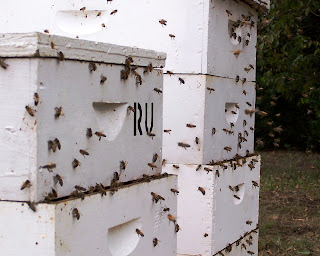While delivering honey on Madison Avenue in colorful
mid-town Memphis, we notice a brick wall covered with striking, artistic
graffiti. A small portion of the wall is particularly catching. Red hearts
reflected by recent rains lead to a man in business attire with a distorted
face and surrounded by symbols of love and wealth. Disturbing figures loom
nearby. Words exclaim, “Enough!” and “Unite.” The simple cartoon rallies
protesters in the Occupy Memphis movement to unite. The graffiti artists
recognize that they can communicate a need to correct a problem, recruit
allies, strengthen bonds within their group, and, together, effect a social
change. As a group they can accomplish more than as individuals. Vivid images
of monopolies, robber barons, and other protest movements are reflected in rain
puddles.
People and honey bees are social creatures. Both
accomplish much through their group efforts, though the creatures and their behaviors
are completely unalike. People often communicate in symbolic language; honey
bees communicate in language silent to us. People communicate by voice, hand
signs, expressions, body language, and writing, as on the Madison Avenue wall.
Bees communicate by dances, vibrations, odors, and pheromones. Bees communicate
among the colony threats to the hive and sources of nectar and pollen. Bees
also convey the need to perform age-related hive duties, produce and store
honey, replace the queen, swarm, and find new nest areas. Bees somehow learn to
do things that none of the bees in the hive have done before. Amazingly, drones
that have never visited a drone concentration area know where they are located;
they create them in the same location year to year. Also, bees that have never
seen a winter know to stockpile food for the next one, storing food for future
generations of bees. Bees communicate the need for work to be done inside and
outside the hive. They share in the building of the nest and the care and
feeding of the brood. Only people communicate with paint on city walls.
--Richard

































